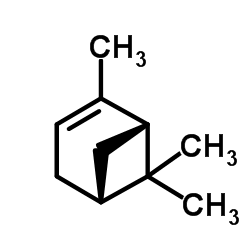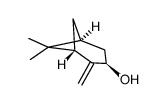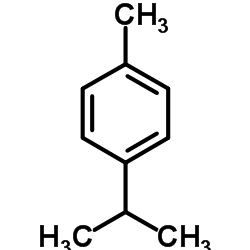515-00-4
| 中文名 | 桃金娘烯醇 |
|---|---|
| 英文名 | (-)-myrtenol, 97 |
| 英文别名 |
(6,6-Dimethyl-bicyclo[3.1.1]hept-2-en-2-yl)-methanol
Bicyclo[3.1.1]hept-2-ene-2-methanol, 6,6-dimethyl- (±)-Myrtenol MFCD00016364 (6,6-Dimethylbicyclo[3.1.1]hept-2-en-2-yl)methanol a-Pinene-10-ol EINECS 208-187-2 |
| 密度 | 1.0±0.1 g/cm3 |
|---|---|
| 沸点 | 224.8±9.0 °C at 760 mmHg |
| 分子式 | C10H16O |
| 分子量 | 152.233 |
| 闪点 | 89.4±0.0 °C |
| 精确质量 | 152.120117 |
| PSA | 20.23000 |
| LogP | 3.22 |
| 蒸汽压 | 0.0±1.0 mmHg at 25°C |
| 折射率 | 1.504 |
| 储存条件 | 储存于阴凉、干燥、通风良好的库房。远离火种、热源。防止阳光直射。包装密封。应与酸类、食用化学品分开存放,切忌混储。储区应备有合适的材料收容泄漏物。 |
| 稳定性 | 1. 按规格使用和贮存,不会发生分解,避免与氧化物接触。 2. 存在于烤烟烟叶中。 3. 以游离态和乙酸酯的形式存在于桉树油和桃金娘油中。 |
| 分子结构 | 1、 摩尔折射率:45.48 2、 摩尔体积(cm3/mol):153.4 3、 等张比容(90.2K):364.5 4、 表面张力(dyne/cm):31.8 5、 极化率(10-24cm3):18.03 |
| 计算化学 | 1.疏水参数计算参考值(XlogP):1.6 2.氢键供体数量:1 3.氢键受体数量:1 4.可旋转化学键数量:1 5.互变异构体数量:无 6.拓扑分子极性表面积20.2 7.重原子数量:11 8.表面电荷:0 9.复杂度:203 10.同位素原子数量:0 11.确定原子立构中心数量:0 12.不确定原子立构中心数量:2 13.确定化学键立构中心数量:0 14.不确定化学键立构中心数量:0 15.共价键单元数量:1 |
| 更多 | 1. 性状:无色液体,有木香、草香、和辛香香气。 2. 密度(g/ cm3,20/4℃):0.978 3. 相对蒸汽密度(g/cm3,空气=1):未确定 4. 熔点(ºC):未确定 5. 沸点(ºC,常压):221-224 6. 沸点(ºC,8kPa):未确定 7. 折射率(n20D) :1.456 8. 闪点(ºC):89.4 9. 比旋光度(º):未确定 10. 自燃点或引燃温度(ºC):未确定 11. 蒸气压(kPa,25ºC):未确定 12. 饱和蒸气压(kPa,60ºC):未确定 13. 燃烧热(KJ/mol):未确定 14. 临界温度(ºC):未确定 15. 临界压力(KPa):未确定 16. 油水(辛醇/水)分配系数的对数值:未确定 17. 爆炸上限(%,V/V):未确定 18. 爆炸下限(%,V/V):未确定 19. 溶解性:不溶于水 |
Synonym:(-)-Pin-2-ene-10-ol; Bicyclo[3.1.1]hept-2-ene-, 6,6-dimethyl-2-(hydroxymethyl)-; Bicyclo[3.1.1]hept-2-ene-2-methanol, 6,6-dimethyl- Section 2 - COMPOSITION, INFORMATION ON INGREDIENTS
Risk Phrases: None Listed. Section 3 - HAZARDS IDENTIFICATION EMERGENCY OVERVIEW
The toxicological properties of this material have not been fully investigated. Potential Health Effects Eye: May cause eye irritation. May cause chemical conjunctivitis and corneal damage. Skin: May cause irritation and dermatitis. May cause cyanosis of the extremities. Ingestion: May cause gastrointestinal irritation with nausea, vomiting and diarrhea. The toxicological properties of this substance have not been fully investigated. Inhalation: May cause respiratory tract irritation. The toxicological properties of this substance have not been fully investigated. Aspiration may lead to pulmonary edema. Inhalation at high concentrations may cause CNS depression and asphixiation. Chronic: No information found. Section 4 - FIRST AID MEASURES Eyes: Immediately flush eyes with plenty of water for at least 15 minutes, occasionally lifting the upper and lower eyelids. Get medical aid. Skin: Get medical aid. Flush skin with plenty of water for at least 15 minutes while removing contaminated clothing and shoes. Wash clothing before reuse. Ingestion: Never give anything by mouth to an unconscious person. Get medical aid. Do NOT induce vomiting. If conscious and alert, rinse mouth and drink 2-4 cupfuls of milk or water. Inhalation: Remove from exposure and move to fresh air immediately. If not breathing, give artificial respiration. If breathing is difficult, give oxygen. Get medical aid. Notes to Physician: Section 5 - FIRE FIGHTING MEASURES General Information: As in any fire, wear a self-contained breathing apparatus in pressure-demand, MSHA/NIOSH (approved or equivalent), and full protective gear. During a fire, irritating and highly toxic gases may be generated by thermal decomposition or combustion. Use water spray to keep fire-exposed containers cool. Vapors may be heavier than air. They can spread along the ground and collect in low or confined areas. Containers may explode when heated. Combustible liquid and vapor. Extinguishing Media: Use water spray to cool fire-exposed containers. Water may be ineffective. Use agent most appropriate to extinguish fire. Use water spray, dry chemical, carbon dioxide, or appropriate foam. Section 6 - ACCIDENTAL RELEASE MEASURES General Information: Use proper personal protective equipment as indicated in Section 8. Spills/Leaks: Clean up spills immediately, observing precautions in the Protective Equipment section. Cover with sand, dry lime or soda ash and place in a closed container for disposal. Remove all sources of ignition. Provide ventilation. Section 7 - HANDLING and STORAGE Handling: Wash thoroughly after handling. Remove contaminated clothing and wash before reuse. Use only in a well-ventilated area. Avoid contact with eyes, skin, and clothing. Keep container tightly closed. Avoid ingestion and inhalation. Keep away from heat and flame. Storage: Keep away from sources of ignition. Store in a tightly closed container. Store in a cool, dry, well-ventilated area away from incompatible substances. Section 8 - EXPOSURE CONTROLS, PERSONAL PROTECTION Engineering Controls: Facilities storing or utilizing this material should be equipped with an eyewash facility and a safety shower. Use adequate general or local explosion-proof ventilation to keep airborne levels to acceptable levels. Exposure Limits CAS# 515-00-4: Personal Protective Equipment Eyes: Wear appropriate protective eyeglasses or chemical safety goggles as described by OSHA's eye and face protection regulations in 29 CFR 1910.133 or European Standard EN166. Skin: Wear appropriate protective gloves to prevent skin exposure. Clothing: Wear appropriate protective clothing to prevent skin exposure. Respirators: A respiratory protection program that meets OSHA's 29 CFR 1910.134 and ANSI Z88.2 requirements or European Standard EN 149 must be followed whenever workplace conditions warrant respirator use. Section 9 - PHYSICAL AND CHEMICAL PROPERTIES Physical State: Clear liquid Color: clear, colorless Odor: None reported. pH: Not available. Vapor Pressure: Not available. Viscosity: viscous Boiling Point: 221 - 222 deg C Freezing/Melting Point: Not available. Autoignition Temperature: Not applicable. Flash Point: 89 deg C ( 192.20 deg F) Explosion Limits, lower: Not available. Explosion Limits, upper: Not available. Decomposition Temperature: Not available. Solubility in water: Not available. Specific Gravity/Density: .9820 g/cm3 Molecular Formula: C10H16O Molecular Weight: 152.24 Section 10 - STABILITY AND REACTIVITY Chemical Stability: Stable under normal temperatures and pressures. Conditions to Avoid: Ignition sources, excess heat. Incompatibilities with Other Materials: Strong oxidizing agents. Hazardous Decomposition Products: Carbon monoxide, carbon dioxide. Hazardous Polymerization: Has not been reported. Section 11 - TOXICOLOGICAL INFORMATION RTECS#: CAS# 515-00-4 unlisted. LD50/LC50: Not available. Carcinogenicity: (-)-Myrtenol - Not listed by ACGIH, IARC, or NTP. Section 12 - ECOLOGICAL INFORMATION Section 13 - DISPOSAL CONSIDERATIONS Dispose of in a manner consistent with federal, state, and local regulations. Section 14 - TRANSPORT INFORMATION IATA Not regulated as a hazardous material. IMO Not regulated as a hazardous material. RID/ADR Not regulated as a hazardous material. Section 15 - REGULATORY INFORMATION European/International Regulations European Labeling in Accordance with EC Directives Hazard Symbols: Not available. Risk Phrases: Safety Phrases: S 24/25 Avoid contact with skin and eyes. WGK (Water Danger/Protection) CAS# 515-00-4: No information available. Canada CAS# 515-00-4 is listed on Canada's DSL List. CAS# 515-00-4 is not listed on Canada's Ingredient Disclosure List. US FEDERAL TSCA CAS# 515-00-4 is listed on the TSCA inventory. SECTION 16 - ADDITIONAL INFORMATION N/A |
|
生态学数据: 该物质对环境可能有危害,对水体应给予特别注意。
|
| 上游产品 0 | |
|---|---|
| 下游产品 8 | |
| 海关编码 | 2906199090 |
|---|---|
| 中文概述 | 2906199090. 其他环烷醇,环烯醇及环萜烯醇. 增值税率:17.0%. 退税率:13.0%. 监管条件:无. 最惠国关税:5.5%. 普通关税:30.0% |
| 申报要素 | 品名, 成分含量, 用途 |
| Summary | 2906199090. cyclanic, cyclenic or cyclotherpenic alcohols. VAT:17.0%. Tax rebate rate:13.0%. . MFN tariff:5.5%. General tariff:30.0% |





![2-(chloromethyl)-6,6-dimethylbicyclo[3.1.1]hept-2-ene结构式](https://image.chemsrc.com/caspic/146/30897-76-8.png)




